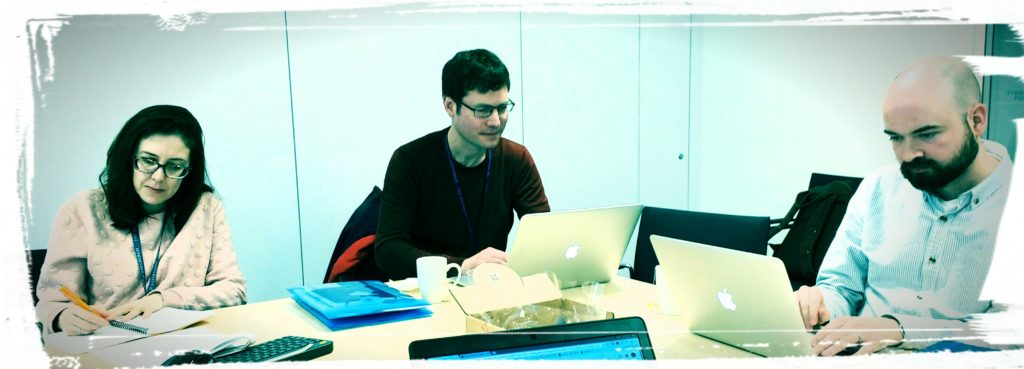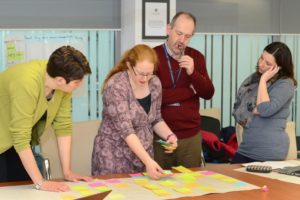I am a Fellow of the Higher Education Academy (FHEA) which I gained in 2007 on completion of a PG Certificate in Professional Education at Queen Margaret University, Edinburgh. I completed my CMALT accreditation in 2009 and reviewed my portfolio in 2016.
Learning technology support in a modern university is closely entwined with support for learning and teaching. In the past it has been considered as a bolt-on or specialist interest but digital skills for teaching are becoming ubiquitous. You can’t enter a teaching space on campus without finding a data projector, computer a lecture recording equipment and teaching takes place both f-2-f and online and in blends of both. My job title is “Learning Technology Advisor” and I work in a team called Educational Design and Engagement within the directorate of Learning Teaching and Web Services, within the Information Services Group at the University of Edinburgh. I’ve been in this role for over 10 years, and while my specific focus changes and develops over time a main part of this is to offer advice and guidance to Academic and Professional Services staff on appropriate use of technology to sound pedagogic principles, in wide range of contexts including campus based, blended and online distance learning . Please see my CV for more context.
I have supported a changing and developing portfolio of tools and services over the years, most recently including Question Mark Perception, which is used for high stakes summative assessment, Collaborate Ultra for meetings and teaching and Social Media tools for Learning and teaching, which includes an excellent online course called 23 Things for Digital Knowledge.
For over two years I’ve been working on a Project “Providing professional development for learning technologists via CMALT cohort“ (Certified Membership of the Association for Learning Technology). To date, 15 professionals accredited via the scheme making U of E the UK institution with the largest number of current CMALT holders (V4)
This relates to teaching and learning in several ways, it is the part of my job where I do the most “teaching” in the traditional sense, planning and delivering workshops, giving feedback on drafts, mentoring and encouraging applicants through the process.

CMALT is a portfolio assessment based on an applicant’s previous experience of working with learning technology (minimum 2 years). Candidates write a portfolio showing how they address four core areas and a specialist area of practice and how that their professional practice align with the principles and values of the scheme. The flexible framework is appropriate for staff in a variety of roles, including technical, academic and leadership.
The CMALT portfolio structure is:
Contextual statement
Core area 1: Operational issues
a) An understanding of the constraints and benefits of different technologies
b) Technical knowledge and ability in the use of learning technology
c) Supporting the deployment of learning technologies
Core area 2: Teaching, learning and/or assessment processes
a) An understanding of teaching, learning and/or assessment processes
b) An understanding of your target learners
Core area 3: The Wider Context
a) Understanding and engaging with legislation, policies and standards
b) Policy
Core area 4: Communication and working with others
Specialist Option(s)
Future Plans
In each area the candidate must frame their response within their experience of technology used for learning teaching and assessment. It is vital that candidates relate their experience to the context – for example its not enough to show you understand the constraints and benefits of a technology in technical terms (capacity, scalability, reliability) if you don’t also explain the constraints and benefits in learning and teaching context (context, level, applicability to learning outcomes).
I support candidates to reflect on their own experience of teaching, learning and assessment and to consider how their roles directly effect this. For example a CMALT candidate is an Academic working on an online distance learning programme – for their students the University of Edinburgh experience is via the Virtual Learning Environment (VLE) and they have come to realise how much control they have over this space (V2).
I’m a CMALT Lead Assessor which has given me experience assessing, writing feedback and working with other assessors. I’m a committee member of the ALT Membership Development Committee , who oversea the CMALT scheme.
I facilitate Edinburgh Learning Design Roadmap (ELDeR) workshops to design or revise courses or programmes.
Learning Design workshops bring together course teams for two days to looking at values, writing learning outcomes to the appropriate SQFA level in the U of E agreed format and then exploring how these can be assessed. At the Programme level workshops participants leave with a storyboard of courses within the programme structure. At the end of the course level workshop the team has a storyboard of the course by themes, activities (student and tutor), feedback and assessment. These workshops are highly interactive and discursive, focusing on building a shared vision within the teams.
Learning design is different from, but related to, curriculum design. I discuss its heritage in this post on V3. It focused on the activities that form part of the learning process from the perspective of all of the participants e.g. what will the students be doing, what will the lecturer or tutor be doing. Initially these were developed for online programmes but are now requested by on campus too.
Learning technologists facilitate these as we can provide advice on ‘how to make this happen’ and can see beyond domain-specific traditions. Academics on a law programme I worked with found it hard to consider other approaches beyond reading as they were convinced ‘that’s how lawyers learn’. Nursing programmes were very keen on reflective portfolios but were less convinced students could learn by reading unless it was related to practice (V1, V4). Learning technologies come from a range of backgrounds and often bring experience of working for other disciplines so we can offer examples from different disciples.

References:
ALT (2016) CMALT guidelines (PDF).
CMALT and Other Frameworks : https://www.alt.ac.uk/certified-membership/cmalt-and-other-frameworks. This page links to a mapping of CMALT to the UKPSF